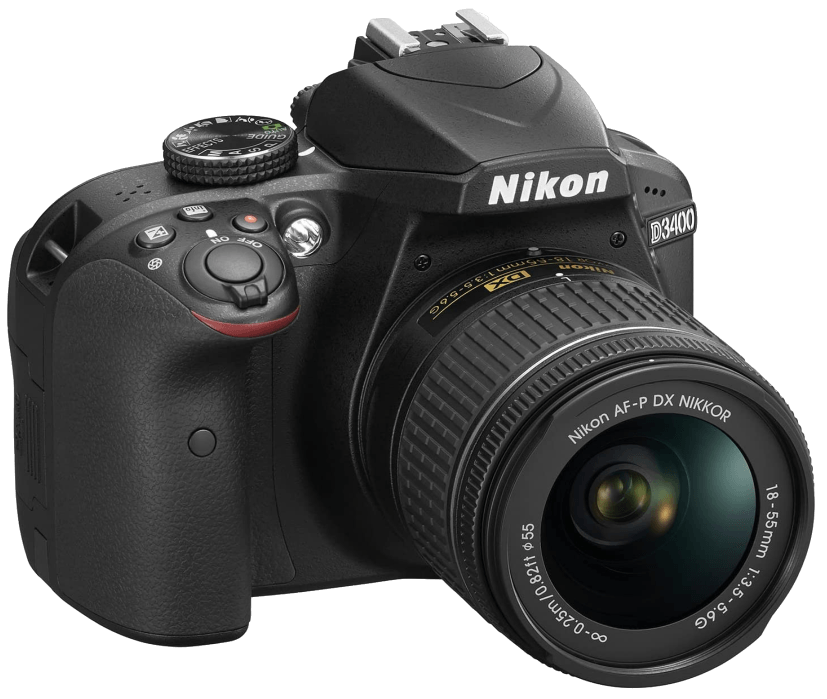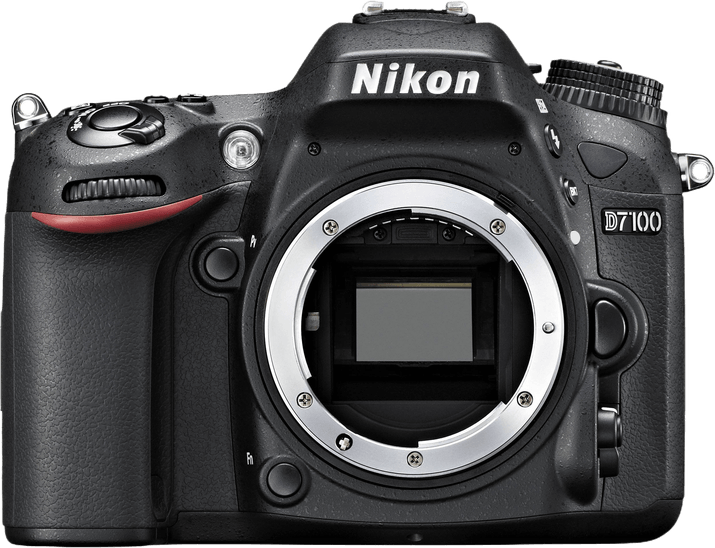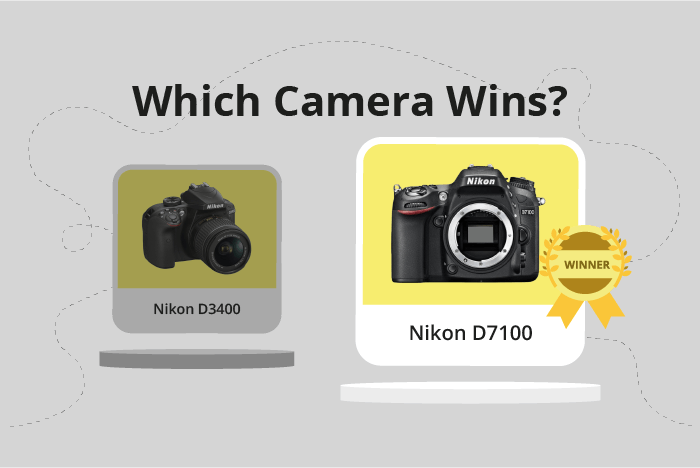Nikon D3400 vs D7100 Comparison
Nikon D3400

Nikon D7100

The Nikon D7100 emerges as the winner with a score of 65/100, while the Nikon D3400 scores 61/100. Both cameras are DSLRs and were released in 2013 and 2016, respectively. They share similar dimensions, with the D7100 measuring 136 x 107 x 76mm and the D3400 at 124 x 98 x 76mm.
The D7100 outperforms the D3400 with its higher score, which may justify its higher launch price of $1200 compared to the D3400’s $650. However, the D3400 has the advantage of being lighter, weighing only 445g, compared to the D7100’s 765g.
Taking these factors into account, the Nikon D7100 is the superior camera in terms of performance, but the Nikon D3400 offers a more lightweight and budget-friendly option for those prioritizing these aspects.
Nikon D3400 vs D7100 Overview and Optics
The Nikon D7100 wins the optics comparison with a score of 67/100, slightly edging out the Nikon D3400’s score of 65/100. Both cameras share several specifications, including a 24-megapixel CMOS sensor, APS-C sensor size, Nikon F DX lens mount, and lack of image stabilization.
The D7100’s superior optics score is due to its faster shooting speed of 6 frames per second compared to the D3400’s 5 frames per second, as well as its Expeed 3 processor. While the D3400 has a marginally higher DXOMARK sensor score of 86 compared to the D7100’s 83, the D7100’s overall performance in optics is still better, thanks to its faster shooting speed and processor.
On the other hand, the Nikon D3400 has a slightly higher megapixel count of 24.2 compared to the D7100’s 24.1, as well as a more advanced Expeed 4 processor. This means the D3400 may provide marginally better image quality and processing capabilities, despite its lower optics score.
Considering each point, the Nikon D7100 is the superior camera in terms of optics due to its faster shooting speed and reliable Expeed 3 processor. However, the Nikon D3400 does have some advantages in image quality and processing with its higher megapixel count and more advanced Expeed 4 processor. Despite these differences, both cameras are solid choices for photographers, with the D7100 being better suited for those who prioritize faster shooting speeds and the D3400 for those who value image quality and processing capabilities.
Nikon D3400 vs D7100 Video Performance
The Nikon D7100 emerges as the winner in the video capabilities comparison, with a score of 57/100, which is just 1 point higher than the Nikon D3400’s score of 56/100. Both cameras share some common video specifications, including Full HD max video resolution and max video dimensions of 1920 x 1080.
The D7100 outperforms the D3400 in a couple of aspects. First, it has time-lapse functionality built-in, which allows for creative video capturing without the need for additional software or accessories. This feature is absent in the D3400. This advantage makes the D7100 more versatile for those who enjoy experimenting with time-lapse photography in their videos.
On the other hand, the D3400 does have a slight edge over the D7100 in terms of max video frame rate. The D3400 can achieve 60fps, while the D7100 is limited to 30fps. This higher frame rate allows for smoother motion capture and can be particularly beneficial for recording fast action scenes or sports events.
Considering the above points, both cameras have their strengths and weaknesses in the video department. The D7100 is the better choice for those who appreciate built-in time-lapse functionality, while the D3400 is more suitable for users who prioritize higher frame rates for smooth motion capture. However, it is important to note that the difference in video capabilities between these two cameras is minimal, with only a 1 point difference in their video scores.
Nikon D3400 vs D7100 Features and Benefits
The Nikon D7100 wins in the features category with a score of 59/100, while the Nikon D3400 scores 54/100. Both cameras share some common specs, such as a 3-inch screen size, no touchscreen, no flip screen, and no GPS. However, there are differences that make the D7100 a better choice in terms of features.
The D7100 has a higher screen resolution at 1,228,800 dots, compared to the D3400’s 921,000 dots. This results in a sharper and clearer display, making it easier to review photos and navigate through menus. The D7100 also has Wi-Fi capabilities, allowing users to transfer images and control the camera remotely via a smartphone or tablet. This feature is lacking in the D3400.
On the other hand, the D3400 has Bluetooth connectivity, which the D7100 does not. This enables the D3400 to maintain a constant connection with a smart device for seamless photo sharing and camera control. However, this advantage may not be significant for some users, as Wi-Fi offers similar functionality.
In conclusion, the Nikon D7100’s higher feature score is due to its better screen resolution and Wi-Fi capabilities. The D3400’s Bluetooth connectivity is its main advantage, but it may not be enough to sway users who prioritize screen quality and Wi-Fi. Ultimately, the choice between these two cameras will depend on the user’s specific needs and preferences.
Nikon D3400 vs D7100 Storage and Battery
The Nikon D7100 surpasses the Nikon D3400 in storage and battery with a score of 76/100 compared to the D3400’s score of 45/100. Both cameras share common specifications in this aspect, such as accepting SD, SDHC, and SDXC memory cards, and lacking USB charging capabilities.
The D7100 excels with its two memory card slots, providing more storage options and flexibility for photographers. This additional slot allows for increased memory capacity and organization of files while shooting. On the other hand, the D3400 has a longer battery life of 1200 shots, compared to the D7100’s battery life of 950 shots. This advantage in battery life allows for extended shooting sessions without needing to replace the battery.
Although the D3400 has a superior battery life, the D7100’s dual memory card slots make it the better option for storage capabilities. Ultimately, the choice between these cameras depends on the user’s preferences and priorities, whether they value additional storage options or longer battery life.
Nikon D3400 vs D7100 – Our Verdict
Are you still undecided about which camera is right for you? Have a look at these popular comparisons that feature the Nikon D3400 or the Nikon D7100:

